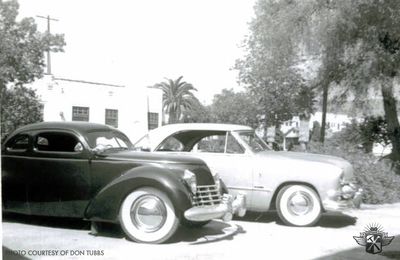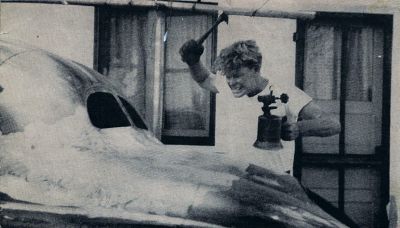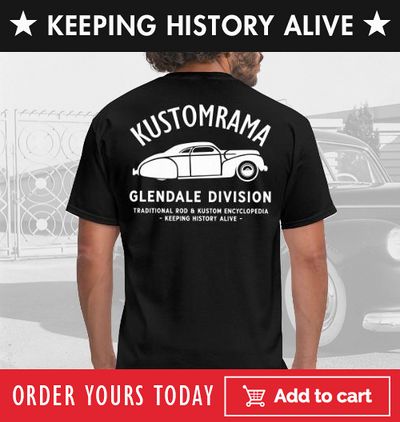Glenn Johnson's 1937 Ford




















1937 Ford Coupe originally owned and restyled by Gamblers of Las Vegas member Glenn Johnson of Las Vegas, Nevada. Glenn got the inspiration to remodel his coupe after seeing a chopped and channeled 1936 Ford his friend Carl Gratz had purchased "ready made" from California. When Glenn set out to build his own custom, he decided to base his build on a 1937 Ford as it was the ugliest car he had ever seen after the 1941 Willys.[1] Before Glenn started working on his own car, he studied Carl's Ford thoroughly. Due to outstanding craftmanship, the secrets of its reconstruction methods remained mysterious to the aspiring customizer. It gave Glenn nothing to go on, and as he had absolutely no knowledge or experience when it came to bodywork, welding or leading, he dove into the job totally unprepared for the many obstacles that would turn up during the build. With the aid of a pencil and plenty of paper, Glenn attempted to theoretically construct his future dream car before the build started. By moving and altering various parts of the body on paper, Glenn visualized the finished product without actual experimentation. After Glenn had settled on the design of the car, his next problem was how to do the restyling. After contacting several experts in the field, he was told to "cut off the top and drop the body over the frame". Glenn's tools at the time consisted of an ordinary clawhammer, a blowtorch and a hacksaw. After he had loaned a friend's welding equipment and purchased a flat body file and a pair of sheet metal shears he set off to do the radical operation. Glenn's wife Vivian helped through during the whole build. As the coupe was Glenn's only means of transportation, it had to be kept in running condition throughout the entire build. At the time, he was traveling 60 miles a day, to and from work, six days a week. The build was started in 1947, and Glenn decided to start with the top. Working outside, he took careful measurements all around to determine where the top would sit if four inches were taken out. Horizontal cuts were scribed on each side of the car, and all glass and garnish rails were removed and laid aside. Glenn began by cutting the the windshield posts at the top where the radius begins at the upper windshield corners. This cut was made perpendicular to the angle of the windshield posts in order to eliminate the necessity of further notching to increase the angle of the top stubs. Only one cut was necessary at the back, just below the point where the top was originally welded to the body. With the top removed, a four inch section was taken from the centerposts. At the base of the windshield posts, on the back side, a narrow V notch was cut. This permitted the posts to be bent back to meet the top in its new position. Removing a few inches of metal from the back part of the quarter-window sills allowed the top's surplus metal to slide down inside the body when the top was replaced. Glenn had decided to set the top lower at the back than in front in order to produce a slight rake. With the top resting on the centerposts, he cut a sufficient amount out of the windshield posts to obtain the angle he wanted. By spreading the center posts attached to the upper top section until they were the same width as the lower post and by pulling the windshield posts back into position, the top was ready to be welded back on. The top had now been dropped four inches up front and 4 1/2 inches in the rear. With the top back in its new lowered position, a noticeable gap remained between the top and the back of the body. This gap was filled with strips of metal which were welded to the body and top at a 45 degree angle. After they were welded in place, a slight radius was punded into the metal. Excess welding was then smoothed off with a borrowed electric sander, leaving the metal ready for leading. Having no experience at all when it came to leading, Glenn refferd to a chemistry book which supplied the answers on how lead adheres to iron. After the top had been chopped, Glenn went on to channel the body six inches over the frame. The fenders, running boards, hood, grille and deck lid were removed before the body was carefully dropped the desired amount over the frame. He sliced and diced areas of the body, including the firewall and the rear wheel openings. Open sections between the body sill and the floor's edge above were filed in with strips of sheet metal and welded in place. In order to keep the rear fenders from protruding back, and to make certain that ample clearance was allowed for the tires, the fenders were raised five inches and moved forward two inches. After shaping them to the contour of the body in their new position, they were welded in place and molded to the body. Strips of flat metal six inches long and two inches high, shaped in a slight arch, were welded end to end at a 45 degree angle between the body and rear fenders. To produce a molded fender effect, a radius was pounded into the strips blending them into the body and fender contours. The front fenders were bolted back onto the frame in their original position and molded to the body as well. The radiator was lowered with brackets made of strap iron. New side panels were made to fit between the fenders and the new lowered position of the hood. They were also molded to the rest of the body. The metal for the hood sides came from old door sections. Up front, Glen spent weeks rearranging the bars of a 1947 Cadillac grille to provide a sloping effect for the front end. The grille was turned upside down, and slots were cut into the inside edges of the fenders to support the grille tips. 1940 Ford headlights were installed as well. Extra metal was shaped and welded into place to form the nosepiece between the hood and grille and to fill the spots where the running boards had joined the fenders. The laborious task of leading and filing smooth all the welded seams took Glenn well over a year. Glenn kept the entire chassis stock, with exception of hydraulic brakes. Power came from a hopped up 1947 Mercury engine that featured a full-race Iskenderian cam, Offenhauser heads and an Edelbrock dual manifold fed through a pair of chromed Stromberg 97s. The front bumper was from a 1941 Cadillac, and the rear bumper came from a 1946 DeSoto. The rear bumper was split to admit a license mounting bracket. Inside, the instruments were arranged in a neat row above the windshield. They were placed there in order to let the driver glance at the gauges without losing sight of the road ahead. The upholstery was done in rolled and pleated ivory and red Naugahyde. The body was painted ruby maroon. A week after the car had been painted and all glass and trim had been reinstalled, tragedy struck as a spark from a smoldering rag ignited the gas tank. Glenn stood helplessly by and watched two years of hard work go up in smoke. Before they were able to put the fire out, the interior was gutted, the glass was cracked, the paint was blistered, and all the lead was puddled on the ground. Glenn wasn't ready to give up his dream car, so he started all over again. In the process of Glenn's experimentation he had come across many shortcuts, so the second time around was much easier for him. Leading work that took hours the first time was done in matter of minutes the second time.[2]
In 1951, before the build was completed, Glenn and his wife Vivian moved to Glendale, California. He was attending Glendale Jr. College, and his friend Don Tubbs think he planned on going to USC to get a degree in engineering. Don was a junior at Glendale High School. who loved being around and working on hot rods. A friend of Don lived across the street from where Glenn and Vivian lived, and Don met Glenn and started hanging out with him after school in 1951 while he was finishing up the car. Glenn would let Don, who owned a mildly customized 1951 Ford Victoria, help out with the car, something that was a real thrill for Don, as Glenn's custom was the best looking custom car in town at the time. Don and Glenn became friends and members of the Glendale Esquires car club. Glenn completed the build in 1951 while living in Glendale, and it landed the cover of Hot Rod Magazine April 1952. The text on the cover read "We Chopped and Channeled our Car at Home", and the story inside was written by Glenn. Spanning over several pages, Glenn described in great details how he built the car without having any experience at all. While Glenn was preparing the car for the photo shoot, he noticed a bubble in the paint on the roof. When he was polishing the car, the bubble popped off. It was a good size chip, and the spot would have shown in the photos, so Glenn decided that he had to be in the photo so he could put his hand over the bad spot.[3]
Don rode along with Glenn in the coupe on several car cruise outings, and he especially remembers when they attended the 1952 Pasadena Auto Show and Reliability Run at Victory Park near the Rosebowl. It was the first annual Pasadena Auto Show and Reliability Run, and Glenn was excited about entering his custom in a real car show. When the boys pulled up to enter the show, they were really surprised as all of the guys in charge of the show came running up to welcome Glenn to the event. He got a real royal welcome, and was directed to a special parking spot. Don remembers Glenn saying "Wow, those guys sure are treating us special". it didn't take long before they found out that the show program had a photo of Glenn's '37 on the cover. The promoters of the show had not asked Glenn for a permission, and they were concerned about how Glenn would react when he found out. Glenn was cool about it as Don recalls, and had no problems with it. At the show, Glenn won the "originality" trophy.[3]
Glenn, Don and the rest of the Glendale Esquires members used to hang out at Bob's Big Boy Drive In restaurant in Toluca Lake, Burbank to talk cars and check out the cute girls. One night Glenn asked Don to ride with him. Don was not allowed to wear his "engineer boots" inside the car, and had to put them in the trunk while they were cruising. That night, when they were arriving at Bob's Drive In, the car went dead just outside the entrance. Glenn rolled the coupe over to the curb and said, "Well, one of us has to crawl out the door window to get help" as there were no mechanical door handles on the car. It was all electric, and the battery was dead. Glenn decided that he was the one to crawl out the window. He took off belt so he would not scratch the paint, and out the window he went. A funny sight for everyone around.[3]
Glenn owned a ranch outside Las Vegas. Around 1955/1956, when Glenn quit driving the coupe, he parked it beside a building at the ranch. It stayed outside for the next 40 years. When Glenn later retired and sold the property in 1992, he decided to take the coupe with him to his new house. The car had survived well in the hot low humidity climate, so in 1999 Glenn decided to restore the car back to its former glory. When Glenn began the restoration it was complete down to the spotlights and hubcaps. The engine Glen installed in the coupe when he first built it was enlarged to 286 cubic inches.[1] After Glenn had restored the coupe he began showing it again. Unfortunately he was only able to put it in one show before he died. Concept car and custom car collector Joe Bortz of Highland Park, Illinois bought Glenn's coupe around 2007. After he got it, Joe had a few finishing touches completed to make the car appear exactly as it did on the cover of Hot Rod Magazine April 1952. It was missing its fender skirts, so Joe had Fran Roxas of Vintage Motorsports make a set of fender skirts for the old custom. Fran did also detail the engine compartment. Glenn had installed a modern tape deck in the dash that Fran pulled out and replaced with an early 1950s radio front.[4]
In 2010 Glenn's old coupe was hand picked to be part of the prestigious Customs Then and Now exhibit at the 2011 Grand National Roadster Show in Pomona, California, an elite gathering of the most historically significant customs in the world.[5] February the same year it was also shown at the Detroit Autorama, and in March of 2011 it was shown at the Amelia Island Concours d’ Elegance.[6]
Magazine Features
Hot Rod Magazine April 1952
Trend Book 105 Restyle Your Car
Hop Up Annual 5
Old Cars Weekly News & Marketplace March 17, 2011
Rolls & Pleats 36
References
Did you enjoy this article?
Kustomrama is an encyclopedia dedicated to preserve, share and protect traditional hot rod and custom car history from all over the world.
- Help us keep history alive. For as little as 2.99 USD a month you can become a monthly supporter. Click here to learn more.
- Subscribe to our free newsletter and receive regular updates and stories from Kustomrama.
- Do you know someone who would enjoy this article? Click here to forward it.
Can you help us make this article better?
Please get in touch with us at mail@kustomrama.com if you have additional information or photos to share about Glenn Johnson's 1937 Ford.
This article was made possible by:
SunTec Auto Glass - Auto Glass Services on Vintage and Classic Cars
Finding a replacement windshield, back or side glass can be a difficult task when restoring your vintage or custom classic car. It doesn't have to be though now with auto glass specialist companies like www.suntecautoglass.com. They can source OEM or OEM-equivalent glass for older makes/models; which will ensure a proper fit every time. Check them out for more details!
Do you want to see your company here? Click here for more info about how you can advertise your business on Kustomrama.























